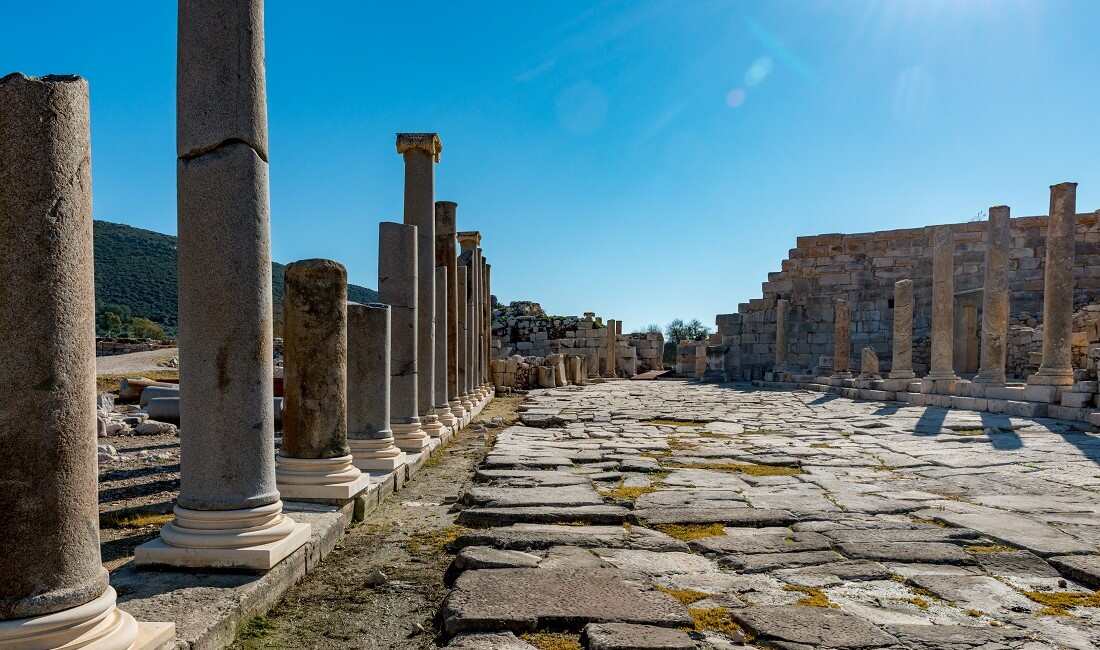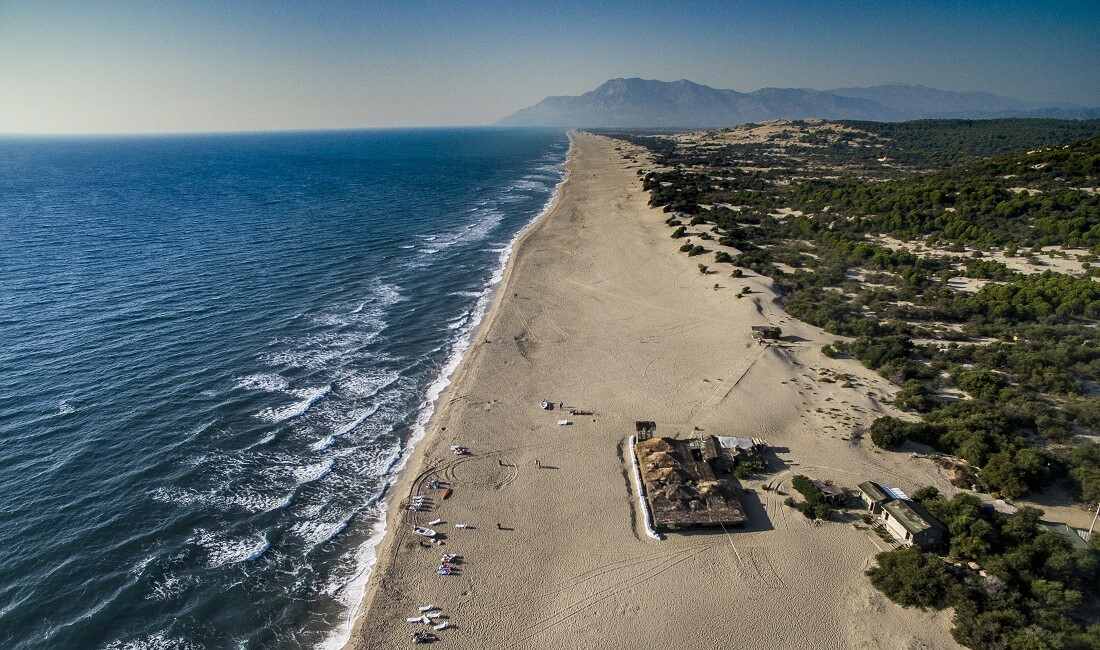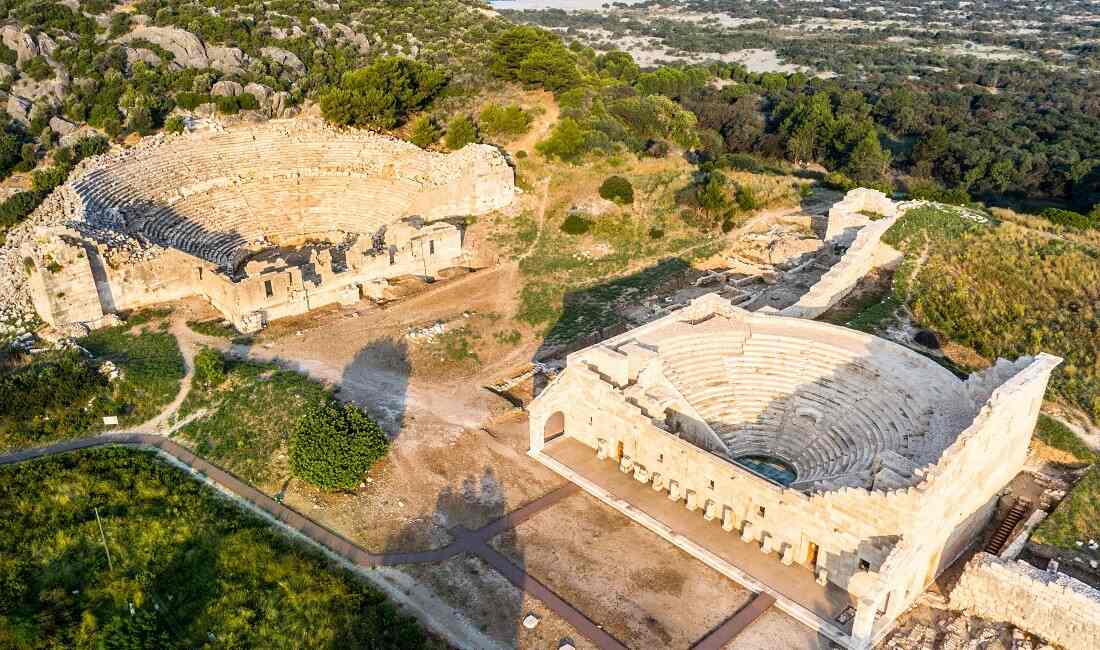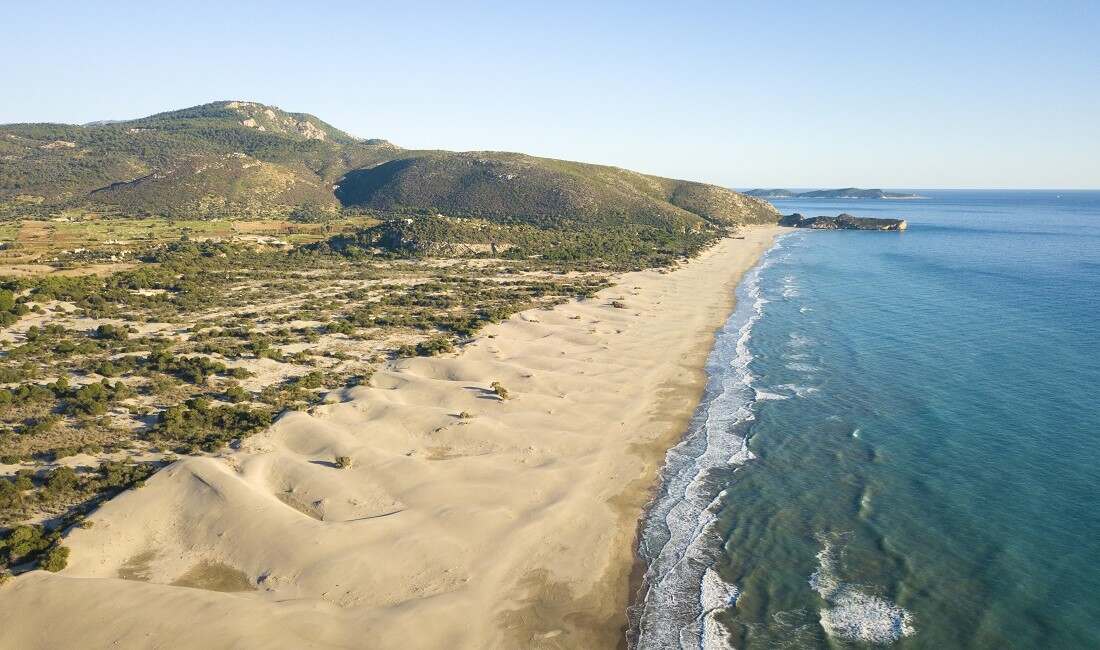
Nestled on the southern coast of present-day Turkey, Patara is a captivating destination that seamlessly blends history and natural beauty. It boasts a rich historical heritage as an ancient city and offers visitors a pristine and picturesque beach. Patara’s unique combination of archaeological wonders and breathtaking landscapes make it a must-visit location for travelers seeking cultural exploration and seaside relaxation.
With a history dating back over 2,000 years, Patara holds a vital place in the ancient world. As one of the principal cities of ancient Lycia, it played a crucial role in maritime trade and cultural exchange. Patara’s strategic location along the Mediterranean coast ensured its prominence and prosperity during various periods, including the Lycian, Hellenistic, Roman, and Byzantine eras. Today, the ruins of Patara stand as a testament to its glorious past, offering glimpses into its former grandeur and providing valuable insights into the ancient world.
Not only is Patara historically significant, but it also boasts natural wonders that add to its allure. The crown jewel of Patara is its pristine beach, which stretches for approximately 18 kilometers (11 miles). This golden sandy expanse is not only visually stunning. Still, it is also ecologically important as it serves as a nesting ground for the endangered loggerhead sea turtles (Caretta caretta). The combination of ancient ruins and a stunning beach makes Patara a destination that seamlessly weaves together history and nature, providing visitors with a truly unforgettable experience.
Patara is an ancient city located on the Mediterranean coast of Turkey. According to legend, Patarus, the son of Apollo and the nymph Rhoeo founded it sometime in the eighth century BCE. Over the centuries, Patara grew into a major maritime and commercial center. Its strategic location along the Mediterranean coast made it a convenient stopover for ships traveling between the Aegean and the Black Sea. The city’s proximity to major trade routes also facilitated flourishing connections with other Mediterranean civilizations.
In the 6th century BCE, Patara became a member of the Lycian League, a confederation of 12 cities in Lycia. The Lycian League was founded to protect the towns of Lycia from outside threats and to promote trade and commerce between the member cities. Patara was also a major religious center. The town was home to the temple of Apollo, one of the most important temples in Lycia. The temple was dedicated to the god Apollo, the patron god of Lycia. The temple was also a popular pilgrimage destination for people from around the Mediterranean.
Patara declined in importance in the 7th century CE. This was due to several factors, including Islam’s rise and trade decline in the Mediterranean. Patara was abandoned in the 11th century CE. Later, in the 19th century, archaeologists rediscovered the city. Today, Patara is an important archaeological site. The town’s ruins, including the temple of Apollo, the Lycian League council house, and the Roman theater, are still visible. Patara is also a popular tourist destination, known for its long sandy beach and its proximity to the ruins of the ancient city.

Throughout its history, Patara witnessed the influence of various civilizations, each leaving its mark on the city. The Lycians, an indigenous people of Anatolia, were among the early inhabitants of Patara and played a pivotal role in shaping its cultural and political landscape. Under Lycian rule, Patara emerged as a prominent city-state, boasting impressive architectural achievements and a distinct cultural identity.
Following the conquest of Alexander the Great, which brought Greek influence to the area, Patara came under the rule of the Persian Empire in the fourth century BCE. The Hellenistic period saw Patara flourish as a center of learning and intellectual pursuits, attracting renowned scholars and philosophers.
During the Roman era, Patara gained further prominence as one of the principal cities of the Lycian League. The Romans expanded and enhanced the city’s infrastructure, constructing impressive buildings and fortifications. Patara became an important administrative, commercial, and cultural hub within the Roman province of Lycia et Pamphylia.
Patara experienced significant events and developments that shaped its history throughout its ancient period. One notable event was the visit of the apostle St. Paul during his journey to Rome, where he reportedly stayed in Patara.
In the 2nd and 3rd centuries CE, Patara enjoyed a period of prosperity and cultural vibrancy. It became renowned as a center for the cult of Apollo, and its oracle attracted visitors from far and wide seeking guidance and divination.
However, with the decline of the Roman Empire and the shift of trade routes, Patara’s importance gradually waned. The city faced various challenges, including invasions, earthquakes, and silting of its harbor. Eventually, Patara fell into decline and was ultimately abandoned, leaving a wealth of archaeological treasures awaiting discovery and exploration.
The historical background of Patara provides a fascinating narrative of the rise and fall of civilizations, showcasing the cultural exchanges and influences that shaped the city’s identity. Today, these ancient remnants are a testament to Patara’s rich past, inviting visitors to delve into its fascinating history.

The Remains of the Ancient City: Patara’s extensive archaeological site offers a glimpse into the layout and structures of the ancient city. Visitors can explore the well-preserved city walls that once enclosed the urban area, protecting it from external threats. The winding streets of Patara lead to various residential areas, where the ruins of houses and buildings provide insight into the daily life of its inhabitants.
The Patara Theater: One of the standout features of Patara is its impressive theater, which dates back to the Hellenistic period. The theater, carved into the hillside, showcases remarkable architectural design and engineering. Theater, concerts, and public meetings were all held there, with a capacity of around 10 thousand people. Visitors can marvel at the well-preserved seating tiers, the stage area, and the stunning backdrop of the surrounding landscape.
The Patara Lighthouse: Situated near the ancient harbor, the Patara Lighthouse (also known as the Tower of Patara) holds historical significance. Built during the Roman era, it was a navigational beacon to guide ships into the harbor safely. The lighthouse stood tall as a symbol of Patara’s importance as a thriving maritime city. While the original structure is no longer standing, the remnants of its foundation and surrounding ruins provide a glimpse into its grandeur.
Other Points of Interest: In addition to the theater and lighthouse, Patara boasts several other notable archaeological sites. The ancient harbor, once a bustling hub of trade and commerce, now allows visitors to explore the ruins of its quays, docks, and warehouses. The Temple of Apollo, dedicated to the Greek god of light and the sun, was a prominent religious site. Although only a few columns remain, it evokes a sense of the temple’s past glory.
The archaeological sites of Patara offer a treasure trove of historical and architectural wonders. Exploring the ruins allows visitors to envision the grandeur and significance of this ancient city. From the impressive theater to the remnants of the lighthouse and the old harbor, each site tells a story of Patara’s rich past and invites visitors to return in time.
St. Nicholas, the revered figure who evolved into the beloved Santa Claus, holds a remarkable place in history, and his birthplace in Patara adds an intriguing layer to his mystique. The ancient city of Patara, nestled along the picturesque southwestern coast of Turkey, provided the nurturing environment for St. Nicholas’s formative years, contributing to his embodiment of the principles of selflessness and compassion. Patara itself, with its rich cultural heritage and vibrant atmosphere, served as a fertile ground for the development of this revered saint. The people of Patara witnessed firsthand St. Nicholas’s extraordinary acts of kindness and boundless generosity, which soon became the stuff of legends. His reputation as a protector of children and a patron saint of sailors resonated far beyond Patara’s boundaries, capturing people’s hearts worldwide.
Today, visitors to Patara can delve into the traces of St. Nicholas’s life, immersing themselves in the historical remnants of the ancient city that once nurtured his spirit. The ruins of Patara stand as a testament to the illustrious past and cultural significance of the birthplace of St. Nicholas. Additionally, the Church of St. Nicholas, located in the nearby city of Demre, offers pilgrims and curious travelers a sacred space to pay homage to the saint. This beautifully preserved church, with its stunning frescoes and serene atmosphere, is a tangible reminder of St. Nicholas’s enduring influence and the reverence he continues to command. The connection between St. Nicholas and Patara serves as a poignant reminder of the profound impact one individual can have on the world, inspiring countless generations to embrace the timeless values of compassion, goodwill, and the joy of giving.

Patara Beach stretches approximately 18 kilometers (11 miles) along the southwestern coast of Turkey, making it one of the longest sandy beaches in the region. The beach’s width varies, but its expansive shoreline provides ample space for visitors to relax and enjoy the surroundings. The soft, golden sand adds to the allure of Patara Beach, inviting visitors to take leisurely walks or bask in the sun.
The waters of Patara Beach are known for their clarity and mesmerizing turquoise hue. The seabed slopes gently, allowing for safe swimming and recreational activities. The gradual slope also contributes to the calmness of the waters, making Patara Beach an ideal destination for families and those seeking a peaceful beach experience.
Patara Beach is of great ecological significance because it is a prime location for loggerhead sea turtle (Caretta caretta) nesting. These ancient creatures return to the beach where they were born to lay their eggs, perpetuating a remarkable cycle of life. Conservation organizations and local authorities have implemented various measures to protect the sea turtles and their habitat. These efforts include monitoring the nesting activity, marking and protecting the nests, and educating visitors about preserving the turtles’ natural environment.
Responsible tourism and environmental awareness are crucial in protecting Patara Beach and its ecosystem. Visitors are encouraged to follow guidelines that minimize disturbance to nesting turtles, such as avoiding artificial light at night and keeping a respectful distance from nesting sites. Together, residents and conservation groups educate visitors about the importance of protecting the ecosystem and encourage them to adopt sustainable lifestyles.
Protecting Patara Beach and its sea turtles symbolizes the dedication to ecological sustainability that characterizes the region. Patara serves as a reminder that humans and nature can coexist when we take the necessary steps to protect and conserve our environment. By embracing responsible tourism practices and fostering environmental awareness, we can ensure that Patara Beach remains a sanctuary for both sea turtles and visitors for generations.
Sand Dunes of Patara
The sand dunes of Patara, nestled along the enchanting southwest coast of Turkey, are a true testament to the wonders of nature. Extending over 18 kilometers, these majestic dunes form a breathtaking landscape where the radiant golden sands harmoniously blend with the crystal-clear turquoise waters of the Mediterranean Sea. What distinguishes these dunes is their remarkable height, soaring up to 20 meters in certain areas. As the gentle breeze sweeps across the coastline, it delicately sculpts the sands, fashioning beautiful undulating shapes that further enhance the allure of this extraordinary natural formation. Every excursion to Patara offers a sensory delight, as the ever-shifting patterns and textures of the dunes create a captivating spectacle that mesmerizes both nature enthusiasts and avid photographers.
Beyond their aesthetic appeal, the dunes of Patara serve a crucial ecological function by acting as a natural shield against the relentless forces of coastal erosion. These dunes act as a robust defense, safeguarding the delicate equilibrium of the surrounding ecosystem. They also contribute significantly to the region’s impressive biodiversity by providing habitat for numerous plant and animal species. The resilient flora that thrives amidst the dunes includes hardy shrubs, grasses, and unique vegetation adapted to harsh and ever-changing conditions. Various bird species, such as larks and sandpipers, gracefully inhabit the dunes. At the same time, small reptiles and mammals have found sanctuary within the sandy slopes. The intricate web of life that the Patara dunes support emphasizes their crucial role in preserving the region’s natural heritage.

Patara Beach has a mythical origin intertwined with the ancient Greek deities Apollo and Leto. According to the myth, Hera, the vengeful goddess, pursued Leto while carrying Apollo and Artemis. When Leto arrived at the Patara shores searching for refuge, the locals welcomed him. On these very sands, Leto gave birth to Apollo, the god of light, music, and prophecy. This association adds a mystical aura to the beach and deepens its cultural significance.
Several mythological stories and figures are associated with Patara. One of these tales describes the Python, a monstrous serpent that Hera sent to torture Leto. Apollo defeated the Python near Patara, further solidifying the connection between the beach and the god. Additionally, Patara is said to be where Apollo received his first oracle, establishing the site’s importance as a center for prophecy and divination in ancient times.
Patara Beach holds significant historical importance as it was once a bustling port city in the ancient world. The town of Patara served as a gateway between Asia and Europe, playing a vital role in maritime trade and commerce. The strategic location of the city’s harbor made it a hub for economic and cultural exchange.
Patara’s harbor facilitated trade routes that connected the city to various regions of the Mediterranean, including Egypt, Syria, and Greece. The port thrived as a center for exporting grain, olive oil, and textiles while serving as a crucial stopover for merchants and travelers. The bustling harbor attracted diverse cultures, fostering cultural exchange and leaving a lasting imprint on the city’s history.
Patara Beach’s cultural and historical significance is rooted in both mythology and tangible historical achievements. The beach’s mythical association with the birth of Apollo and its connection to ancient prophecies add a layer of enchantment to the site. Furthermore, Patara’s role as a major port city in antiquity contributed to its economic prosperity and cultural vibrancy. Exploring the shores of Patara Beach allows visitors to immerse themselves in the rich tapestry of mythology and history, experiencing firsthand the deep-rooted cultural and historical legacy that resonates within this coastal gem.

Preserving Patara Ancient City and Patara Beach comes with its own set of challenges. For the ancient city, natural elements such as weathering, erosion, and vegetation growth pose ongoing threats to the structural integrity of the ruins. Human activities, including vandalism and unauthorized excavation, threaten the site’s preservation. As for Patara Beach, the increase in tourism and development can put pressure on the delicate coastal ecosystem and nesting sites of sea turtles. Pollution, improper waste management, and disturbance to the natural habitat are additional challenges that must be addressed.
Authorities and organizations have actively protected and conserved Patara Ancient City and Patara Beach. Officials have implemented conservation plans to monitor and maintain the ancient ruins, including regular archaeological surveys, structural stabilizations, and restoration projects. Educational programs and awareness campaigns are necessary to engage visitors and locals in preservation efforts. Protecting sea turtle nesting areas, controlling beachfront development, and encouraging sustainable tourism are all central goals of conservation efforts along Patara Beach. The collaboration between local communities, environmental organizations, and governmental bodies is vital in ensuring the long-term preservation of the ancient city and the beach.
Visitors come to Patara Ancient City for its historical significance and the opportunity to explore the well-preserved ruins. The ancient city offers a captivating glimpse into the lives of the Lycians, Greeks, and Romans who once inhabited the area. The impressive architecture, such as the theater and the city walls, and the serene atmosphere create a unique and immersive experience for history enthusiasts and culture seekers.
Patara Beach, on the other hand, attracts tourists with its natural beauty and tranquil ambiance. The pristine sandy shore, clear turquoise waters, and the opportunity to witness nesting sea turtles make it a sought-after destination for nature lovers and beach enthusiasts. The beach’s spaciousness allows visitors to find a peaceful spot away from crowds, making it an ideal retreat for relaxation and rejuvenation.
With its ancient city and pristine beach, Patara holds immense historical and natural significance. The city’s roots trace back to ancient times, witnessing the rise and fall of civilizations, and its ruins offer a glimpse into a bygone era. With its stunning beauty and ecological importance, Patara Beach captivates visitors with its crystal-clear waters and stretches of white sand.
To truly grasp the allure of Patara, you should encounter it firsthand. Visitors are encouraged to explore the ancient ruins of Patara, wander through its streets, and marvel at the well-preserved theater and other architectural marvels. They can also bask in the beauty of Patara Beach, taking in its tranquil ambiance and enjoying the refreshing waters. The combination of history, natural splendor, and mythical connections make Patara a destination that offers travelers a unique and captivating experience.
By visiting Patara, one can embark on a journey through time, walking in the footsteps of ancient civilizations and immersing oneself in the breathtaking beauty of the beach. It is a destination that offers a perfect blend of history, culture, and natural wonders, leaving visitors with lasting memories and a deeper appreciation for the rich heritage of this remarkable place.
